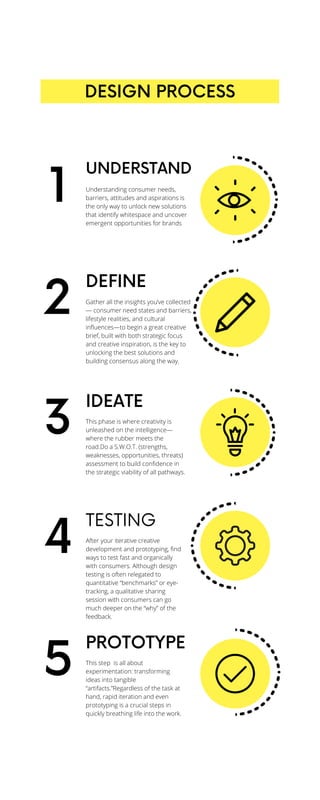Design Thinking Process: The Journey from Empathy to End-Product
•
0 gostou•23 visualizações
The document outlines a 5-step design process: 1) Define the problem by understanding consumer needs, barriers, and aspirations. 2) Ideate potential solutions through creativity and a S.W.O.T. analysis. 3) Test ideas quickly with consumers through both quantitative and qualitative methods to understand feedback. 4) Prototype ideas into tangible artifacts through rapid iteration. 5) Gather all insights to create a creative brief that unlocks the best solutions.
Denunciar
Compartilhar
Denunciar
Compartilhar
Baixar para ler offline

Recomendados
Mais conteúdo relacionado
Semelhante a Design Thinking Process: The Journey from Empathy to End-Product
Semelhante a Design Thinking Process: The Journey from Empathy to End-Product (20)
"Creativity in public relations" by Andy Green chapter 8 "Red light thinking:...

"Creativity in public relations" by Andy Green chapter 8 "Red light thinking:...
Coaching Material about innovation processes - Part 2.pdf

Coaching Material about innovation processes - Part 2.pdf
The Digital Innovators' Guide: How Services Companies Launch Successful Digit...

The Digital Innovators' Guide: How Services Companies Launch Successful Digit...
Solonia.Teodros_Introduction to Design Thinking.pdf

Solonia.Teodros_Introduction to Design Thinking.pdf
Lean Innovation for Micro Enterprises Module 4 Design Thinking

Lean Innovation for Micro Enterprises Module 4 Design Thinking
Gateway to Agile: Product Discovery - Lean UX and Design Sprints

Gateway to Agile: Product Discovery - Lean UX and Design Sprints
Mais de OliviaEdna
Mais de OliviaEdna (8)
A step-by-step guide to the development of back-end systems.pdf

A step-by-step guide to the development of back-end systems.pdf
Everything you need to know about prototyping .pdf

Everything you need to know about prototyping .pdf
Everything you need to know about prototyping .pdf

Everything you need to know about prototyping .pdf
Último
Call Girls in Pratap Nagar, 9953056974 Escort Service

Call Girls in Pratap Nagar, 9953056974 Escort Service9953056974 Low Rate Call Girls In Saket, Delhi NCR
Último (20)
Business research proposal mcdo.pptxBusiness research proposal mcdo.pptxBusin...

Business research proposal mcdo.pptxBusiness research proposal mcdo.pptxBusin...
Call Girls in Ashok Nagar Delhi ✡️9711147426✡️ Escorts Service

Call Girls in Ashok Nagar Delhi ✡️9711147426✡️ Escorts Service
Call Us ✡️97111⇛47426⇛Call In girls Vasant Vihar༒(Delhi)

Call Us ✡️97111⇛47426⇛Call In girls Vasant Vihar༒(Delhi)
毕业文凭制作#回国入职#diploma#degree澳洲弗林德斯大学毕业证成绩单pdf电子版制作修改#毕业文凭制作#回国入职#diploma#degree 

毕业文凭制作#回国入职#diploma#degree澳洲弗林德斯大学毕业证成绩单pdf电子版制作修改#毕业文凭制作#回国入职#diploma#degree
Call Girls in Pratap Nagar, 9953056974 Escort Service

Call Girls in Pratap Nagar, 9953056974 Escort Service
How to Be Famous in your Field just visit our Site

How to Be Famous in your Field just visit our Site
8377877756 Full Enjoy @24/7 Call Girls in Nirman Vihar Delhi NCR

8377877756 Full Enjoy @24/7 Call Girls in Nirman Vihar Delhi NCR
Design Thinking Process: The Journey from Empathy to End-Product
- 1. UNDERSTAND Understanding consumer needs, barriers, attitudes and aspirations is the only way to unlock new solutions that identify whitespace and uncover emergent opportunities for brands DESIGN PROCESS 1 DEFINE 2 IDEATE This phase is where creativity is unleashed on the intelligence— where the rubber meets the road.Do a S.W.O.T. (strengths, weaknesses, opportunities, threats) assessment to build confidence in the strategic viability of all pathways. 3 TESTING After your iterative creative development and prototyping, find ways to test fast and organically with consumers. Although design testing is often relegated to quantitative “benchmarks” or eye- tracking, a qualitative sharing session with consumers can go much deeper on the “why” of the feedback. 4 PROTOTYPE This step is all about experimentation: transforming ideas into tangible “artifacts.”Regardless of the task at hand, rapid iteration and even prototyping is a crucial steps in quickly breathing life into the work. 5 Gather all the insights you’ve collected — consumer need states and barriers, lifestyle realities, and cultural influences—to begin a great creative brief, built with both strategic focus and creative inspiration, is the key to unlocking the best solutions and building consensus along the way.